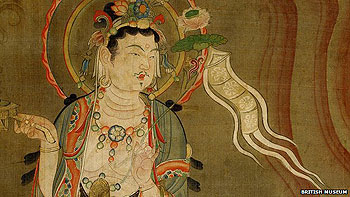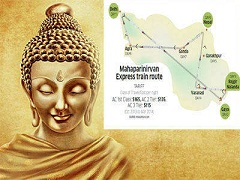Dear Dharma friends
Sukhihontu.
We have ended the 13 parts series of Vajrayana teaching notes which was diligently and faithfully prepared by Margaret Ong. We hope this little gesture of ours find resonance with friends who are seeking the spiritual path.
I will now start another series of Dharma sharing. This time, 12 letters written by Vui Kong, then a 21 year old, while waiting for his death sentence. He was arrested in 2007 with 47.27 grams (1.667 oz) of heroin. Execution is mandatory in Singapore where the crime occurred, for a person convicted of trafficking in more than 15 grams (0.53 oz) of diamorphine. He was 19 years old at the time, and thus not an adult (the age of majority in Singapore is 21 years).
Due to Vui Kong's young age, it sparked off protestations from the sympathetic populace both sides of the border (Vui Kong is a Malaysian) and the defence lawyer succeeded in getting a stay of execution. However, on 14 May 2010, the Court of Appeal of Singapore ruled that the mandatory death penalty imposed by the Misuse of Drugs Act did not infringe Article 9(1) and 12(1) of the Constitution.
After the appeal failed, human rights support groups rallied around and started to campaign to have the sentence commuted. It received overwhelming support particularly from both Singaporean and Malaysian especially in view that Vui Kong was underage at the time of the crime and he seemingly was not aware that he was a 'mule' in this saga.
Vui Kong, 21, started writing letters on April 22, 2011 and continued in the next 12 weeks to Yetian, a member of the Save Vui Kong Campaign, as he faces death sentence. These letters were published at Malaysiakini, a Malaysian on-line news portal.
These poignant letters have a lot of Dharma teachings and learnings. At a time where most will most probably break down psychologically and emotionally especially in his predicament, Vui Kong showed exemplary disposition. His simple letters oozes out gargantuan portions of faith, contentment, patience, equanimity, acceptance and repentance. Nearer to the end, on the twelfth letter he displayed bravery not many people can say they possess. And in spite of knowing it could be weeks or even days that the death penalty will be carried out.
At that time, I signed the petition appealing the sentence on Vui Kong to be commuted and I saved the letters as they appeared on Malaysiakini. After the last letter, I had completely forgotten about Vui Kong until last November I heard that his death sentence was commuted. You can imagine my joy!
I would like to share these letters with you as I somehow feel we could all learn and benefit from a real tragic-turn-celebration-of-life story in our midst. These letters will appear every Monday of the week for the next 12 weeks.
With Metta, Kevin
P/S: [In July 2012 the Singapore government agreed to ratify changes to the mandatory death sentence for drug trafficking and murder offenses - those currently pending sentence of execution may apply to have their sentence of execution changed to life imprisonment. On 14 November 2013, Yong's death penalty was officially lifted. He has become the first drug trafficker on death row to have his sentence reduced to life imprisonment and 15 strokes of the cane, under amendments made to the Misuse of Drugs act].
Sukhihontu.
We have ended the 13 parts series of Vajrayana teaching notes which was diligently and faithfully prepared by Margaret Ong. We hope this little gesture of ours find resonance with friends who are seeking the spiritual path.
I will now start another series of Dharma sharing. This time, 12 letters written by Vui Kong, then a 21 year old, while waiting for his death sentence. He was arrested in 2007 with 47.27 grams (1.667 oz) of heroin. Execution is mandatory in Singapore where the crime occurred, for a person convicted of trafficking in more than 15 grams (0.53 oz) of diamorphine. He was 19 years old at the time, and thus not an adult (the age of majority in Singapore is 21 years).
Due to Vui Kong's young age, it sparked off protestations from the sympathetic populace both sides of the border (Vui Kong is a Malaysian) and the defence lawyer succeeded in getting a stay of execution. However, on 14 May 2010, the Court of Appeal of Singapore ruled that the mandatory death penalty imposed by the Misuse of Drugs Act did not infringe Article 9(1) and 12(1) of the Constitution.
After the appeal failed, human rights support groups rallied around and started to campaign to have the sentence commuted. It received overwhelming support particularly from both Singaporean and Malaysian especially in view that Vui Kong was underage at the time of the crime and he seemingly was not aware that he was a 'mule' in this saga.
Vui Kong, 21, started writing letters on April 22, 2011 and continued in the next 12 weeks to Yetian, a member of the Save Vui Kong Campaign, as he faces death sentence. These letters were published at Malaysiakini, a Malaysian on-line news portal.
These poignant letters have a lot of Dharma teachings and learnings. At a time where most will most probably break down psychologically and emotionally especially in his predicament, Vui Kong showed exemplary disposition. His simple letters oozes out gargantuan portions of faith, contentment, patience, equanimity, acceptance and repentance. Nearer to the end, on the twelfth letter he displayed bravery not many people can say they possess. And in spite of knowing it could be weeks or even days that the death penalty will be carried out.
At that time, I signed the petition appealing the sentence on Vui Kong to be commuted and I saved the letters as they appeared on Malaysiakini. After the last letter, I had completely forgotten about Vui Kong until last November I heard that his death sentence was commuted. You can imagine my joy!
I would like to share these letters with you as I somehow feel we could all learn and benefit from a real tragic-turn-celebration-of-life story in our midst. These letters will appear every Monday of the week for the next 12 weeks.
With Metta, Kevin
P/S: [In July 2012 the Singapore government agreed to ratify changes to the mandatory death sentence for drug trafficking and murder offenses - those currently pending sentence of execution may apply to have their sentence of execution changed to life imprisonment. On 14 November 2013, Yong's death penalty was officially lifted. He has become the first drug trafficker on death row to have his sentence reduced to life imprisonment and 15 strokes of the cane, under amendments made to the Misuse of Drugs act].
 It held a treasure trove of 50,000 Buddhist paintings and manuscripts dating back to the 5th Century.
It held a treasure trove of 50,000 Buddhist paintings and manuscripts dating back to the 5th Century.
 So,
when the Railways started a train that would explore the Buddhist
trail, I booked a seat. And it was with great expectation that I boarded
the Mahaparinirvan Express early October from Delhi's Safdarjung
station, marigold garland of the IRCTC (a corporate impostor spinoff of
the Railways) in hand, while liveried bearers insisted on carrying my
unwieldy backpack aboard.
So,
when the Railways started a train that would explore the Buddhist
trail, I booked a seat. And it was with great expectation that I boarded
the Mahaparinirvan Express early October from Delhi's Safdarjung
station, marigold garland of the IRCTC (a corporate impostor spinoff of
the Railways) in hand, while liveried bearers insisted on carrying my
unwieldy backpack aboard.